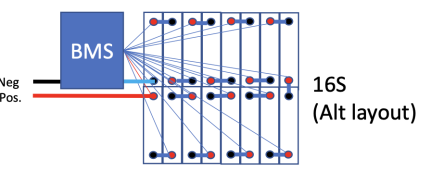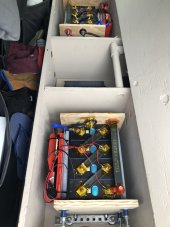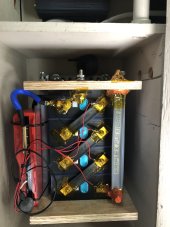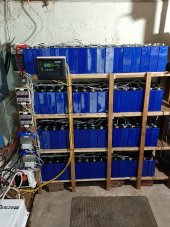I'm having trouble finding a source in USA for tinned or silver flashed copper bars that I want to use to make custom busbars for LF280K cells that have the threaded studs so I am limited in thickness because of that. The busbars that came with the cells look like about 2mm thick but thinnest tinned/silver flashed I've found so far has been 0.25" thick which I think would be too thick if have to have two on single terminal along with the nut.
You are using an out of date browser. It may not display this or other websites correctly.
You should upgrade or use an alternative browser.
You should upgrade or use an alternative browser.
Source of tinned/silver flashed copper bars?
- Thread starter rhino
- Start date
Onlinemetals.com has some. Not sure how good they are but I've seen them referenced.
Example:
 www.onlinemetals.com
www.onlinemetals.com
Example:
Order 0.25" x 0.75" Copper Full Round Edge 110-H02 Silver Flash Online, Thickness: 0.25", Width: 0.75"
Order 0.25" x 0.75" copper full round edge 110-h02 silver flash and other metal-working products online at OnlineMetals.com®, Thickness: 0.25 inch, Width: 0.75 inch
Symbioquine
Solar Enthusiast
- Joined
- Jul 6, 2021
- Messages
- 428
I'm having trouble finding a source in USA for tinned or silver flashed copper bars that I want to use to make custom busbars for LF280K cells that have the threaded studs so I am limited in thickness because of that. The busbars that came with the cells look like about 2mm thick but thinnest tinned/silver flashed I've found so far has been 0.25" thick which I think would be too thick if have to have two on single terminal along with the nut.
Why buy the copper already tinned if you're going to be modifying it? If you're going to be cutting/drilling/etc, you'll be damaging the tinned surfaces anyway.
In my mind it's better to either buy ready-made bus-bars (e.g. through Amy Wan on Alibaba) or buy plain copper bar stock to modify then do the tinning - either yourself or pay to have it done.
That contact area against the flat part of the cell terminal would still be tinned. Even those fancy flexible copper busbars don't have the sides of them tinned.Why buy the copper already tinned if you're going to be modifying it? If you're going to be cutting/drilling/etc, you'll be damaging the tinned surfaces anyway.
I want busbars that are longer then what they provide because I am not going to put the battery in a "fixture" and using those standard busbars puts the cells too close together.In my mind it's better to either buy ready-made bus-bars (e.g. through Amy Wan on Alibaba) or buy plain copper bar stock to modify then do the tinning - either yourself or pay to have it done.
BentleyJ
Solar Wizard
Blue Sea Bus Bars
 www.bluesea.com
www.bluesea.com
BusBars - Blue Sea Systems
Engineering high quality marine electrical components for safety, reliability and performance
Symbioquine
Solar Enthusiast
- Joined
- Jul 6, 2021
- Messages
- 428
That contact area against the flat part of the cell terminal would still be tinned.
Two points; (You may already know these.)
You probably want to put tape or maybe sacrificial plywood over the bus bar before drilling/cutting/etc. Otherwise it can be hard to avoid scratches from the tools and removed material.
Your bits/blades better be extra sharp if you go this route. Copper is so soft that it is really easy to accidentally push up a raised area around the holes/edges being cut - which is easy to fix if you can sand the whole bar surface against a reference plane, but probably not fixable if you're trying to keep the tin plating intact.
Personally, I prefer to do all the rough drilling/cutting/etc, sand the contact surfaces to a (near) perfect plane, then do the tinning. It makes things a bit simpler, but your way can probably work too...
Symbioquine
Solar Enthusiast
- Joined
- Jul 6, 2021
- Messages
- 428
Blue Sea Bus Bars
OP was asking about bus bars for their battery assembly itself. I don't think Blue Sea makes that kind of bus bar. Do they?
yabert
Solar Enthusiast
+1Copper is so soft that it is really easy to accidentally push up a raised area around the holes/edges being cut - which is easy to fix if you can sand the whole bar surface against a reference plane, but probably not fixable if you're trying to keep the tin plating intact.
You will probably need to rework with a countersink tool, a file or sandpaper in the hole area, so I will be interest to know why you want this surface finish.
S Davis
Solar Enthusiast
- Joined
- Sep 25, 2021
- Messages
- 607
Just get the flexible buss bar, it is fully tined and can be ordered in a bunch of thickness’s and widths. I bought it in 79” lengths when I put my batteries together.
Attachments
Hedges
I See Electromagnetic Fields!
- Joined
- Mar 28, 2020
- Messages
- 20,692
Thanks. Those are the 0.25" I've found and two stacked would be half inch. I thought that would be too thick for the welded on studs. There should be a message here somewhere specifying the stud length.
If a single bar is too thick, you could countersink for nut.
Try to do everything with single bars. May depend on layout of multiple cells.
If you need stacked bars, possibly can stack with a bolt, rather than stacking over stud.
I could visualize a nut with flange on top and extended threads that could fit inside oversize hole in top bar, compressing it against bottom bar. Whether available or not, I haven't looked.
WindWizard
Solar Enthusiast
This is a DIY forum so why not DIY? Copper pipe has two thickness type M or L.. I just purchased some 1/2' 10' pipe and cut it to length, pounded it flat, drilled some holes in it, sanded it and plated it. It has worked fabulously for me and it is so much cheaper than the alternative.
Attachments
I didn't think of thatIf a single bar is too thick, you could countersink for nut.
I had just done a 2P16S battery (in a "fixture") which necessitated 2 bars on 4 cell terminals:Try to do everything with single bars. May depend on layout of multiple cells.

But the next battery was going to simply be a 1P16S (not in a fixture which is why I needed the longer then standard busbars) so I then realized after looking at that again it won't require doubling any terminal:

So the 0.25" bars originally mentioned by @SparkyJJO would in fact work ?
Thanks everyone for making me realize my oversight
Would both sides end up with a raised area when using a drill press? I would only care about the plating on the side touching the flat part of terminal itself.Your bits/blades better be extra sharp if you go this route. Copper is so soft that it is really easy to accidentally push up a raised area around the holes/edges being cut - which is easy to fix if you can sand the whole bar surface against a reference plane, but probably not fixable if you're trying to keep the tin plating intact.
Since I realized now that I don't need to stack any bars I'm wondering if I should just use aluminum instead.
yabert
Solar Enthusiast
Way more affordable and easy to work withif I should just use aluminum instead.
Simply don't forget scotch brite + no-ox or mg chem 847
I've gone aluminum for my bars. Matching materials and all. I just went double thick to make up for the lower conductivity. I need to finish them up still (yeah I bought my cells a year ago and haven't finished this. Amazing what having 2 little kids running around and a 3rd one in the middle of everything does as far as free time!)
What dimension bar are you going to be using?I've gone aluminum for my bars. Matching materials and all. I just went double thick to make up for the lower conductivity. I need to finish them up still (yeah I bought my cells a year ago and haven't finished this. Amazing what having 2 little kids running around and a 3rd one in the middle of everything does as far as free time!)
I have 1 inch wide by 1/4 inch thick aluminum bars. For copper I could have used 1/8 inch thick.
I got them from Home Depot, 96 inches long, shipped to my door for 27 bucks. I've hacksawed them, just need to clean the edges, drill the holes, then clean them up real good.
In the process of re-reviewing my stuff, I saw my inverter wants circuit protection on each of the two battery feeds to it. I have 250A fuses for my batteries but my Radian wants 175A breakers on each battery input (each input derated 125% is 104A draw, not sure why such a high breaker size). Anyway, gotta figure that out now.
I got them from Home Depot, 96 inches long, shipped to my door for 27 bucks. I've hacksawed them, just need to clean the edges, drill the holes, then clean them up real good.
In the process of re-reviewing my stuff, I saw my inverter wants circuit protection on each of the two battery feeds to it. I have 250A fuses for my batteries but my Radian wants 175A breakers on each battery input (each input derated 125% is 104A draw, not sure why such a high breaker size). Anyway, gotta figure that out now.
Symbioquine
Solar Enthusiast
- Joined
- Jul 6, 2021
- Messages
- 428
Would both sides end up with a raised area when using a drill press? I would only care about the plating on the side touching the flat part of terminal itself.
Yes possibly. Depends a lot on technique and the quality of the tools. If you have a really sharp bit and advance the bit at the rate that it can cut cleanly, then you will probably be fine. On the other hand, if the bit is dull or the wrong amount of speed/force is used it can push material up around the entry point and/or push material out around the exit point. Obviously, you also should use a progression of bits - not just jumping to the desired size.
yabert
Solar Enthusiast
1/8 x 1'' aluminum busbar is roughly equivalent of copper 1/0 AWG.I have 1 inch wide by 1/4 inch thick aluminum bars. For copper I could have used 1/8 inch thick.
So, except if the battery is connect to a fully load 7 kW + inverter, there is no reason to use 1/4'', especially for such a short distance.
I'm a huge fan of doing more with less ?
Soooooo right! ?Amazing what having 2 little kids running around and a 3rd one in the middle of everything does as far as free time!
Similar threads
- Replies
- 1
- Views
- 261
- Replies
- 8
- Views
- 865






